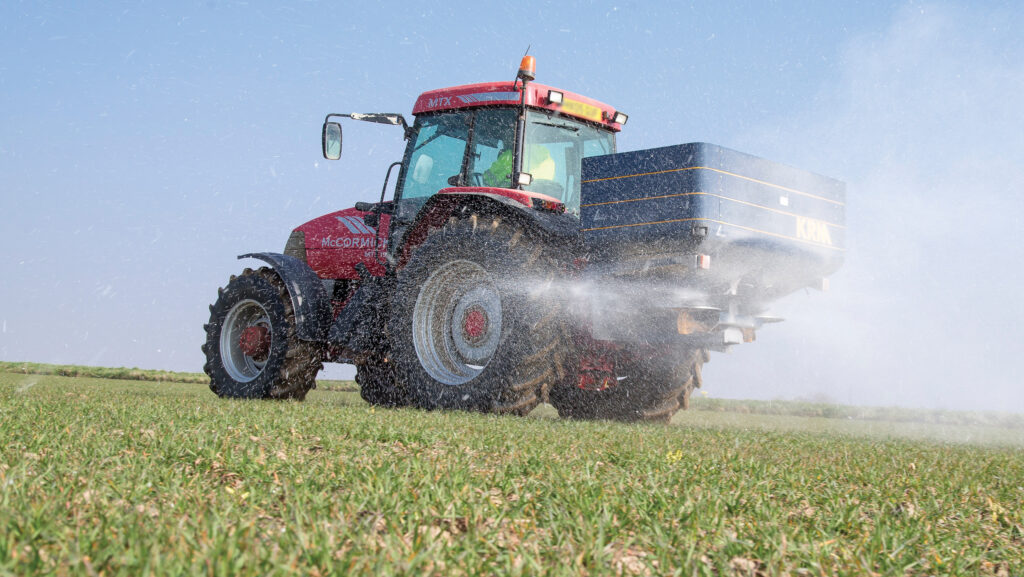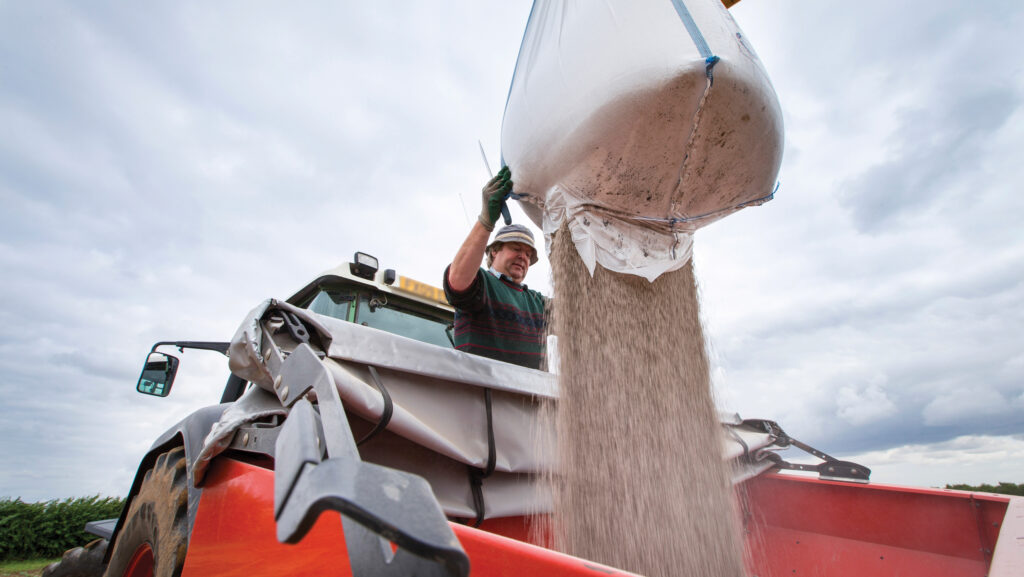How the carbon tax on fertiliser will impact farm businesses
 © GNP
© GNP A Carbon Border Adjustment Mechanism (Cbam) is due to be implemented by the government from 1 January 2027, leading to higher fertiliser costs on farm.
However, the industry is still in a debate over quite how severe the impact will be.
Cbam restrictions are being introduced as part of a push towards net zero and will place a carbon tax on imported goods from some of the most emissions-intensive industries, such as fertiliser.
Various factors such as tariff rates, carbon prices, and any tax-free allowances will play a role in determining the full cost impacts of the mechanism on farm businesses.
See also: Fertiliser prices steady as concerns mount over future tax
James Warner, managing director of co-operative United Oilseeds, says that the idea of Cbam on paper is laudable, and the whole industry does need to be concerned about the environment.
However, there is a risk it could end up taxing N consumption, but not imports of other products.
He says: “It will create an unlevel playing field and we will essentially be offshoring our environmental problems.”
Modelling by United Oilseeds indicates that countries such as Australia, which also use N to grow rapeseed, will have a competitive advantage over the UK’s domestic rapeseed growers.
Mr Warner adds: “By essentially increasing the cost of nitrogen here and increasing the cost of production by roughly £15/t on rapeseed, we are not actually going to reduce our environmental impact, we will just end up importing more product from elsewhere.
“Our demand continues to go up in the UK, but that is being met by imports of other products or rapeseed itself.”
Mr Warner warns that harsh lessons can be learned from the neonicotinoids ban, where the policy negatively impacted UK production.
“In the space of a decade, we have seen the rapeseed crop drop to a quarter of what it was, almost all related to the neonicotinoids ban,” he says.
“At the same time, demand has continued to go up and it is increasingly met by imports. Around 65% of imports come from non-EU countries, and most of these will have been treated with neonicotinoids, which can’t be used here.”
Mr Warner concludes that similarly Cbam may not mean N consumption is reduced globally – it will just be used more intensively somewhere else in the world.
Consultation
A consultation was carried out last year by the government to assess the impact of a carbon tax on imported goods such as fertiliser.
The NFU fed into that consultation and provided modelling to the Treasury on the impact a carbon tax would have on farm businesses.
It established that the arable sector would be particularly badly hit, with fertiliser accounting for 12% of total farm costs and almost 40% of crop-specific expenditure.
“The Treasury came back and said the modelling was really good, but they also wanted to look at the retail prices on the shelves and how Cbam would impact on that,” Sanjay Dhanda, senior economist at the NFU, recalls.
The NFU then worked with the AHDB to study the impact specifically on milling wheat prices and production.
It found that a significant increase in production would be required in the UK to keep prices at current levels due to the higher fertiliser costs.
Mr Dhanda says the NFU is calling for some of the income collected by the Treasury through the carbon tax to be redistributed to the farming sector.
“We modelled what the Treasury gains from the Cbam liability as a proxy for their annual revenue from the carbon tax.
“We saw that revenue for the Treasury increases as carbon prices increase.”
Clarity
The NFU also wants more clarity from government on the exact rates and time period for Cbam, in order to reduce uncertainty and help improve business confidence.
“We know it’s coming, we know there is going to be a phased approach, and there will be free allowances.
“But we don’t know the trajectory of how they are going to be phased out.”
It is understood that allowances will be phased out completely by 2034, at which point Cbam will be applied at its full rate.
Cbam has received scrutiny from the wider farming sector.
Both Liberal Democrat food and farming adviser Stuart Roberts, and former NFU president and crossbench peer Baroness Minette Batters spoke out against it at a conference earlier in the year.
Both raised concerns over domestic production being undercut by imports.
House of Lords debate
Farmers Weekly understands a 10-minute debate is scheduled to take place in the House of Lords on Wednesday 12 March to discuss the impact of the Carbon Border Adjustment Mechanism on fertiliser prices.
Manufacturers predict fertiliser price impact
Several fertiliser manufacturers have warned of increases in excess of £50/t as a result of the new import tax.
Rob Buck, UK sales director at fertiliser specialist Nitrasol, says the tax would potentially lead to higher costs for farmers, food processors and consumers and do nothing to reduce carbon emissions.
However, figures by trade body the Agricultural Industries Confederation (AIC), which represents over 95% of the UK fertiliser sector, suggest that free allowances could help to dramatically reduce this figure during the first few years of implementation.

© GNP
AIC modelling shows that, assuming an initial 80% free allowance, the actual cost would come in at less than £10/t, assuming a £36/t Cbam rate.
Similar modelling by consultancy firm Andersons also suggests the initial figures of around £50/t on urea banded around in the autumn, may end up being closer to £23/t to £24/t.
James Webster-Rusk, senior agribusiness analyst at Andersons, caveats this by saying this is based on a nominal carbon price of £35/t, which is a value that has been traded in the past 12 months.
But this value is due to be recalculated quarterly, which could mean future upswings or downswings if carbon prices move.
“Fundamentally, Cbam is going to be a challenge in terms of addition to cost, but perhaps not as big as many may have initially feared.”
He says assuming a urea price of £400/t and a Cbam rate of £25/t, it would add roughly an extra £10/ha to the cost of growing wheat.
“There are going to be moving parts within this. The allowances we currently have to decarbonise will reduce over time.”
Several traders told Farmers Weekly that fertiliser supplies are tight and prices are likely to remain firm at least in the short term for both granular and liquid product, even before factoring in any future tax.
EU Carbon Border Adjustment Mechanism
The EU is due to impose its own Carbon Border Adjustment Mechanism from the start of next year, a full 12 months ahead of the UK’s timeline.
Such differing timelines and Cbam rates could lead to trade frictions between the UK and EU at a time when the government is working to more closely align with its largest trading partner.
In the House of Commons on 6 February, Labour Cabinet Office minister Nick Thomas-Symonds said: “Together with our friends and neighbours in the EU, we have over £800bn worth of trade.
“It is clearly in our national interest to lower trade barriers pragmatically in that space.
“Energy is very much a priority for the discussions — specifically the Emissions Trading Systems (ETS) and linkage.
“The existing trade and co-operation agreement commits the UK and the EU to considering that.”
Adam Berman, director of policy and advocacy at Energy UK, says the only way to avoid damage to Northern Ireland’s economy is through linking the UK and EU trading schemes.
“The existing UK-EU Trade and Cooperation Agreement opens the door to linkage, but it’s time for both sides to walk through,” adds Mr Berman.
The Labour government’s ambitions for a closer working relationship with the EU could lead to some more realignment over Cbam and the ETS.
The NFU suggests that linking the ETS between the EU and the UK will be the main issue moving forward.
Sanjay Dhanda, senior economist at the NFU, says: “We import the most fertiliser and they are our biggest trade companion.
“If we are buying fertiliser at £300/t and the EU carbon price for that accounts for £15/t, but the UK carbon price is at £20/t, then they pay that £5/t extra.
“If they are both aligned at the same level of trade it would be much easier and there is less likely to be other trade implications.”
EU exemptions
EU tax commissioner Wopke Hoekstra confirmed at a European Parliament subcommittee on 6 February that the EU is looking into simplifying Cbam.
The EU is also expected to consult on possible exemptions from Cbam introduced for the majority of EU companies.
Mr Hoekstra told the Financial Times that less than 20% of the companies in scope were responsible for more than 95% of the emissions.
It is unknown at this stage whether similar exemptions will be considered by the UK government.
